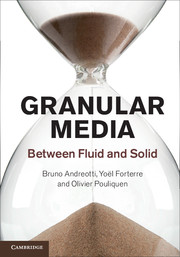1 - Introduction
Published online by Cambridge University Press: 05 June 2013
Summary
Definition and examples of granular media
From sand to cereals, from rock avalanches to interplanetary aggregates like Saturn's rings and the asteroid belt (Fig. 1.1), granular media form an extremely vast family, composed of grains with very different shapes and materials, which can span several orders of magnitude in size. However, beyond this great diversity, all these particulate media share fundamental features. They are disordered at the grain level but behave like a solid or a fluid at the macroscopic level, exhibiting phenomena such as arching, avalanches and segregation.
In this book, we shall broadly define a granular medium as a collection of rigid1 macroscopic particles, whose particle size is typically larger than 100 μm (Brown & Richards, 1970; Nedderman, 1992; Guyon & Troadec, 1994; Duran, 1997; Rao & Nott, 2008). As we shall see in Chapter 2, this limitation in size corresponds to a limitation in the type of interaction between the particles (Fig. 1.2). In this book, we will focus on non-Brownian particles that interact mainly by friction and collision. For smaller particles, of diameter between 1 μm and 100 μm, other interactions such as van der Waals forces, humidity and air drag start to play an important role as well. This is the domain of powders. Finally, for even smaller particles, those of diameter below 1 μm, thermal agitation is no longer negligible. The world of colloids then begins (Russel et al., 1989).
- Type
- Chapter
- Information
- Granular MediaBetween Fluid and Solid, pp. 1 - 14Publisher: Cambridge University PressPrint publication year: 2013



